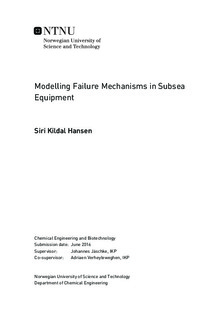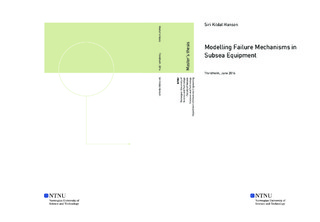| dc.description.abstract | The oil and gas industry is recently facing a challenge to increase the efficiency and reduce the costs. One way to reduce costs is to better optimize the maintenance strategy. By applying failure mechanism models it could be possible to predict equipment degradation rates and estimate the remaining equipment lifetime based on some controllable input parameters. The operation could then be optimized for maintenance, safety and cost, which would be beneficial for both the company and the environment.
The aim of this master thesis is to provide an overview of important failure mechanisms in subsea equipment and how they can be modelled. and to apply some of these models in a simple subsea production system.
\noindent A literature review was performed in order to get an overview of important failure mechanisms in subsea equipment and how they can be modelled. The main focus has been on sand erosion, but failure mechanisms such as corrosion, erosion-corrosion and mechanical wear have also been included. Finally a case study was performed to see how sand erosion failure models can be used to predict equipment degradation and estimated lifetime of equipment. A base case was simulated to see how the system behaved with respect to sand erosion, and a parameter study was done to see how single parameters could affect failure rates and estimated equipment lifetime.
It was found that the major failure mechanisms in subsea equipment are erosion, corrosion and mechanical wear. The case study showed that it is indeed possible to use failure mechanism models to predict equipment lifetime as a function of simple input parameters. The simulations appear to give reasonable results when compared to theory. However, there is some uncertainty about the validity of some of the results from the parameter study because of deviation from expected behaviour. It is believed that this could be because of parts of the model being extrapolated beyond its range of validation. | |

